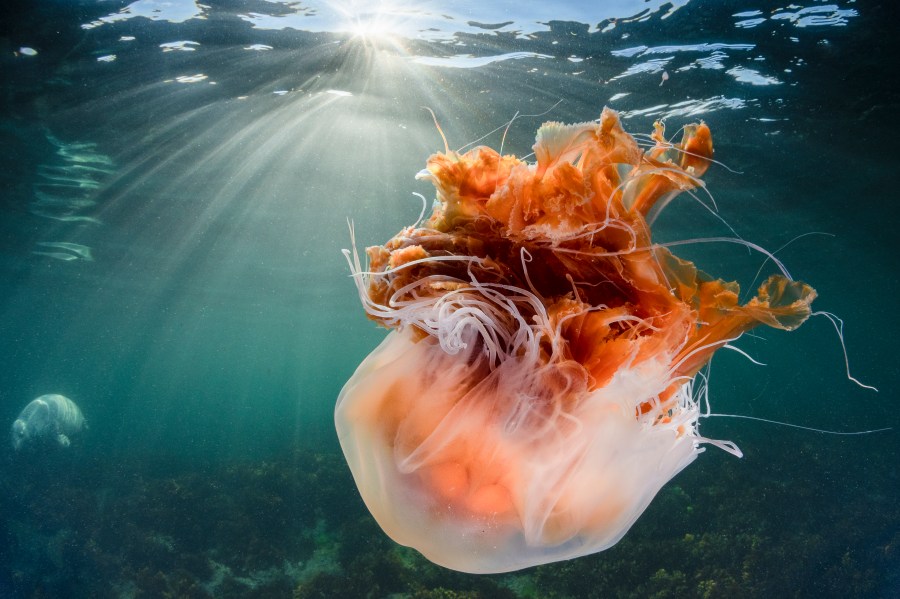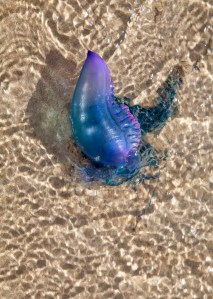Jellyfish sightings in UK waters were up 32 per cent last year, NATALIE FRENCH speaks to the Marine Conservation Society to find out more.
Jellyfish have existed for over 500 million years – longer than the dinosaurs – making them one of the most adaptable animals on the planet, despite the fact they have no brain.
These curious creatures are more than 95 per cent water with circular muscles, a basic set of nerves at the base of their tentacles and central mouth for feasting on fish, zooplankton and small crustaceans. While some are bioluminescent and glow in the dark, others have a sting powerful enough to kill a human.
Over 2000 different species have been identified across the globe (so far); seven of which float in the UK seas. The Irukandji jellyfish can be as small as a cubic centimetre, while the lion’s mane can grow up to two metres wide; its tentacles can reach 120 feet long – that’s longer than a blue whale.
Lots of places on earth, including our UK shores, are seeing large swarms of jellyfish leaving the scientific community questioning if our oceans are likely to become jelly soup. But why the surge? Angus Jackson, seasearch officer at the Marine Conservation Society (MCS) explains: “There are a variety of factors that affect the number and distribution of jellyfish populations. In warm waters with plentiful food, jellyfish reproduce rapidly, appearing in very large numbers we call blooms. If this occurs within a period of stormy weather or consistent onshore winds, then many jellyfish can end up in coastal waters where they become stranded.”
The increase in jellyfish sightings is likely to be a combination of favourable conditions for growth and reproduction, weather conditions moving them towards the shore, and greater awareness of the public about the value of citizen science and willingness to submit their records.”
While jellyfish can be destructive – a mass swarm closed down an entire nuclear powerplant in Japan – and often get a bad rap for their stinging sensibilities, they can also bring many positives to our oceans, says Jackson: “Jellies are an important part of the marine ecosystem, among other things they are a source of food for turtles, hosts for symbiotic or parasitic crustaceans, contribute to the wider food-web by eating plankton, and their bells provide shelter for small fish. They are also often very beautiful to look at.”
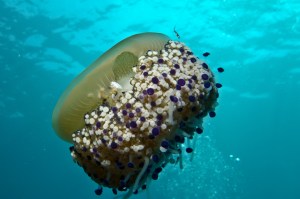
You can spot our resident jellyfish all over the UK coast from May to September; Barrel jellyfish (fondly known as dustbin lid jellyfish) are more common in the south west of England, while lion’s mane jellyfish prefer the northerly UK seas.
“The number of jellyfish sightings tends to increase from April, peaking in the summer months and then decreasing through autumn,” says Jackson. “A small number of records persist through the winter. In 2023, we saw a peak of over 520 records in June.”
The National Jellyfish Survey has been running for over 20 years, in a bid to record data and help predict future trends, explains Jackson: “We encourage members of the public to submit records of jellyfish and other species that they see to relevant recording programmes, such as the Marine Conservation Society wildlife sighting programme, Seasearch and iRecord.”
“There are also lots of online resources and social media groups out there that will help with identification. Our wildlife sightings programme provides valuable information about the sizes of jellyfish populations and the annual reports can highlight interesting patterns.”
You may even be lucky enough to spot a leatherback – the largest sea turtle – which feeds on jellyfish during the summer months. According to the MCS, six of the world’s seven marine turtle species have also been spotted in the UK and Irish seas.
https://www.mcsuk.org/what-you-can-do/citizen-science/sightings/jellyfish-sightings/
7 species of jellyfish found in our UK shores
Barrel jellyfish (Rhizostoma pulmo)
Barrel jellyfish have a spherical, solid rubbery bell, which can be white, pale pink, blue or yellow and is fringed with purple markings. They don’t have tentacles, but eight thick, frilled arms hang from the manubrium (found in the underside centre of the bell, with the mouth and arms at its tip).
Size: up to one metre in diameter.
Sting: mild
Moon jellyfish (Aurelia aurita)
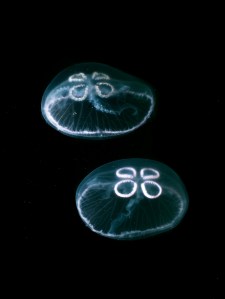
Moon jellyfish have a transparent, umbrella-shaped bell edged with short hair-like tentacles. They’re often recognised by the four distinct pale purple gonad rings in the bell. The manubrium has four short, frilled arms.
Size: up to 40cm in diameter.
Sting: mild
Lion’s mane jellyfish (Cyanea capillata)
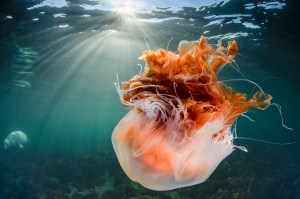
Lion’s mane are large and have a large reddish brown, umbrella-shaped bell with a mass of long, thin hair-like tentacles, as well as short, thick, frilled and folded arms.
Size: usually 50cm, but can reach 2 metres in diameter
Sting: Be very careful, this jellyfish stings.
Blue jellyfish (Cyanea lamarckii)
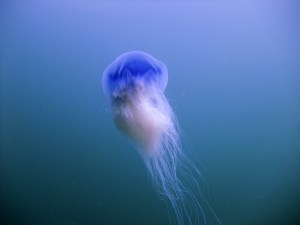
Blue jellyfish are a similar shape to the Lion’s mane jellyfish but are smaller and have a blue bell through which radial lines can be seen. Confusingly, a yellow colour variant also occurs in UK waters.
Size: up to 30cm
Sting: mild
Compass jellyfish (Chrysaora hysoscella)
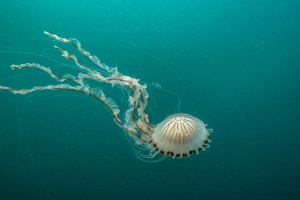
Compass jellyfish typically varies in colour but they usually have a pale umbrella-shaped bell with brownish V-shaped markings. They have 24 long, thin tentacles and four long, thick, frilled arms hang from the manubrium.
Size: up to 30cm
Sting: Careful, this jellyfish stings.
Mauve stinger jellyfish (Pelagica noctiluca)
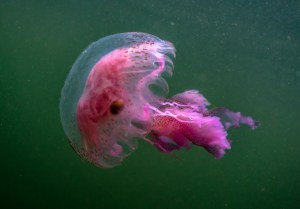
Mauve stingers have a deep bell with pink or mauve warts and eight hair-like tentacles. The manubrium has four longer frilled arms with tiny pink spots.
Size: relatively small, growing up to just 10cm
Sting: Be very careful, this jellyfish stings.
Portuguese man o’ war (Physalia physalis)
This isn’t a jellyfish, but a floating colony of hydrozoans. The Portuguese man o’ war has a distinctive transparent, gas filled float with a crest. They’re blue-purple in colour, with many hanging ‘fishing polyps’ below that may be tens of metres long.
These are extremely dangerous to humans due to their powerful sting. They rarely occur in the UK but should be reported to the local authorities if found in large numbers.
Size: relatively small, growing up to just 10cm
Sting: Be extremely careful, this animal stings.
Did you know?
Jellyfish are a type of ‘cnidarian’…
Named after the Greek word for “sea nettle’, cnidarians are jelly-like marine animals which have radical symmetry and sting their prey using cells on their tentacles called ‘cnidocytes’, which explode when stimulated.
They have very short lifespans…
Although some smaller species of jellyfish only live for a few hours, larger species like lion’s mane can live for a few years.
Some jellyfish can turn back their biological clock…
Jellyfish begin as a polyp, before becoming an ‘ephyra’ and then an adult ‘medusa’. But, if injured or starved, or in water which is either too hot or cold, an adult Turritopsis dohrnii can drop to the seabed and become a polyp all over again.

